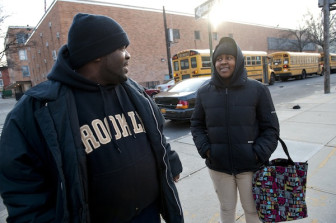
Ronald Johnson and his daughter Felicia in 2012. The two are part of a pilot program to provide supportive housing to families involved in the child welfare system.
We read with interest your series on the De Blasio Administration’s efforts to end tragedies attributed to child maltreatment (“The Limits of Protection: Can Mayor’s Push Reduce Child Abuse Deaths,” authored by Rachel Blustain, December 16, 2014, and “The Limits of Protection: Fixing Child Abuse Investigations,” also by Rachel Blustain, December 17, 2014, and, lastly, “The Limits of Protection: Fighting the Fear of ACS,” same author, December 18, 2014).
Child welfare systems alone are not sufficient to support the complex needs of vulnerable families. As the articles suggest, public service systems need to work together to provide holistic support to families. A great example of this is CSH’s Keeping Families Together supportive housing pilot.
In your reports, Commissioner for New York City’s Children’s Services, Gladys Carríon, specifically champions the Administration’s focus on preventive measures, also a pillar of Keeping Families Together, and shares important facts with your readers. She notes the Mayor’s new Children’s Cabinet is examining overly-bureaucratic impediments between city agencies impacting child safety and ways to eliminate them, including better coordination between her team and the Department of Homeless Services, another fundamental tenet of Keeping Families Together.
The Commissioner reveals a sad reality that was the impetus for Keeping Families Together: approximately 25 percent of the families in the city’s homeless shelters are child welfare-involved.
The Keeping Families Together pilot, funded by Robert Wood Johnson Foundation and designed and implemented by CSH, sought to answer the question: Could supportive housing permanently end homelessness, child neglect and maltreatment, and foster care placement among homeless families with chronic and high levels of child welfare system involvement?
Supportive housing is data-driven and evidence-based. It takes full advantage of the marriage of affordable homes with on-site or accessible community-based services designed to keep the tenant(s) stable and housed. In the case of child welfare-involved families, the services are tooled to meet the needs of the entire family and avoid the unnecessary placement of children in foster care when the stresses of unstable housing and other issues trigger the possibility of homelessness and child welfare involvement.
Families receiving supportive housing through Keeping Families Together had long histories of contacts with the child welfare system, including multiple investigations, incidences of maltreatment and child removals. The children of these 29 families had consumed more than 3,000 foster care days in just the two years prior to placement. Two years after placement into supportive housing, 92% of the families remained housed, open child welfare cases decreased by 61%, children’s school attendance rates increased from 60% to 80% and no children were
removed from their parents. Foster care days decreased by 77%.
We already know allowing children to stay in the care of their parents is the best option so long as we can help the entire household reach stability and safety, and that’s what the pilot proved Keeping Families Together can do.
So successful was Keeping Families Together, the U.S. Department of Health and Human Services Administration for Children and Families took up the cause and joined with more philanthropic sponsors to launch a nationwide demonstration project that further explores the potential of this model to reduce child welfare cases. Five communities across the country are involved in the demonstration and interest in Keeping Families Together is growing.
While the U.S. government has long recognized the housing needs among child welfare system-involved families, reflected in rental assistance programs like the U.S. Department of Housing and Urban Development’s Family Unification Program (FUP) Vouchers, the demonstration represents the first federal investment specifically focused on creating supportive housing to reduce child welfare system involvement among homeless and precariously housed families. As such, it reflects the belief that supportive housing holds tremendous potential in ending the revolving doors of homelessness, parental behavioral health challenges, child neglect and maltreatment, and child removal among the highest need families.
Locally, New York City Mayor Bill De Blasio and his cabinet deserve credit for zeroing in on this issue as well as accelerating the exploration of innovative initiatives to prevent trauma that often place children and families in harm’s way. As Rachel Fee’ editorial articulately concluded in City Limits on December 19, 2014, the De Blasio Administration and New York Governor Mario Cuomo also face an ideal opportunity to spur the creation of even more supportive housing options, including the successful Keeping Families Together model, by inking the Campaign 4 NY/NY housing now.
If approved soon, this effort could directly speed the development of another 30,000 supportive housing units and open the doors for many more families seeking help through Keeping Families Together.
The promise of Keeping Families Together shows us that we can effectively address the needs of families experiencing homelessness and unstable housing, and recurring child welfare system involvement.
It is a solution that roots out the causes of generational poverty that doom family after family to cycles of despair. Supportive housing provides the stability, safety nets and dignity families desperately need to get ahead, and changes their lives forever.
Mayor De Blasio and Governor Cuomo are poised to move the ball forward here in New York City. By signing the Campaign 4 NY/NY housing agreement, they can ensure additional supportive housing and that more child welfare-involved family cases will have happy endings.
City Limits coverage of child welfare is supported by the Ira W. DeCamp Foundation.








